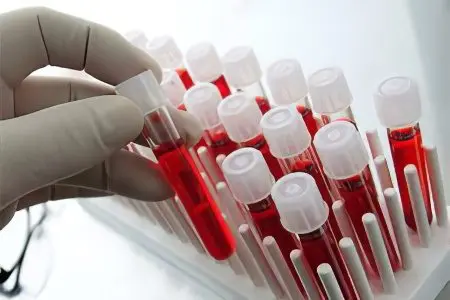Contents
What is T4 hormone (thyroxine)?

T4 – thyroid hormone produced by cells of the thyroid follicles. Thyrocytes synthesize thyroglobulin from the amino acid and iodine, which is a precursor of thyroxin. Thyroglobulin accumulates in the follicles, and if necessary, thyroxine is formed from it by division into fragments.
The main action of the hormone T4 is to accelerate catabolism – the process of obtaining energy from energetically significant metabolites (glycogen, fat). Excessive concentration of thyroxine in the blood leads to palpitations, irritability, and weight loss. But this does not mean that the hormone is harmful, these are just symptoms of its overdose. Normally, tetraiodothyronine maintains the tone of the nervous system, pulse rate and adequate metabolism.
The T4 hormone is not the most active thyroid hormone, for comparison, its activity is almost ten times lower than that of triiodothyronine. The latter is also called the T3 hormone, since its formula contains 3 iodine atoms. T3 can be formed in the cells of the gland itself, as well as in the cells of the body from its predecessor, thyroxine. In fact, it is a more active metabolite of T4.
Hormones T3, T4 are also called thyroid hormones., since they are secreted by the thyroid gland, referred to in Latin as “thyroid”. TSH is also sometimes referred to as thyroid, but this is erroneous, because it is formed by the pituitary gland, located in the brain, and controls the hormone-forming function of the gland.
Often, along with a blood test for the hormones TSH, T3, T4, antibodies to TPO and thyroglobulin are simultaneously determined. Typically, endocrinologists use these indicators to diagnose thyroid pathologies. Sometimes thyroid hormones are examined during the treatment of a disease in order to determine its dynamics and the effectiveness of the prescribed therapy. This article will provide information about what the T4 hormone is, what functions it performs in the body, and how the analysis of its content is interpreted.
The T4 hormone belongs to the group of iodine-containing thyroid hormones. Its chemical formula contains two tyrosine amino acid residues and four iodine halogen atoms. T4 hormones are synonymous with tetraiodothyronine and thyroxine. The substance got its name because of the number of iodine atoms contained in the molecule. Due to the simple structure, the concentration of tetraiodothyronine can be easily determined in the laboratory. For the same reason, the hormone can be synthesized artificially, which is used in hormone therapy.
Hormone T4 in the blood
In the bloodstream, the T4 hormone is found mainly in a protein-bound state. When thyroxine is formed in the thyroid follicles, it is captured by a special protein – thyroxine-binding globulin (TSG). This substance performs a transport function, delivering the hormone to the cells of the body. That small amount of non-protein-bound thyroxine is called free T4. It is this fraction that is responsible for providing the biological effect. The part of the hormone that is associated with TSH is called T4 bound. If you separately determine free and bound T4 in the blood, and then add these values, you get total T4.
In the body, free thyroid hormones (free T4, free T3) have the main effect, so their content is of the greatest importance for determining thyroid pathologies. In laboratories, most often they conduct a blood test for thyrotropin and free T4. The TSH indicator is used to assess the regulation of the thyroid gland by the pituitary gland, and free T4, as the main hormone of the gland, directly reflects its function. The concentration of free T4 is increased in hyperthyroid conditions or as a result of an overdose of hormonal agents used to treat hypothyroidism.
T4 hormone analysis

In the clinical practice of endocrinologists, the analysis of TSH, T4 hormones is the most commonly used diagnostic method. Hormonal studies are prescribed in various combinations, taking into account the symptoms and economic possibilities of the patient.
At the initial visit to the endocrinologist, if the patient has no pronounced symptoms, it may be enough to take an analysis for the hormones TSH, T4, T3. As for the last two hormones, it is better to investigate their active, i.e., free fractions. In cases where a patient is receiving thyreostatics for the treatment of an early stage of Graves’ disease (diffuse toxic goiter), it is better to determine only free hormones T3 and T4. Under the action of thyreostatic drugs, these indicators rapidly decrease, while the TSH level seems to be late and does not have time to decrease.
If a patient has been treated for a long time for insufficient gland function, then for periodic monitoring of the quality of therapy, it is sufficient to determine only the concentration of thyroid-stimulating hormone (TSH). Free T4 is examined only if there are special indications. You should know that in the case of taking thyroxine, a blood test for the hormone T4 can be taken only before taking it. If this rule is not observed, the result of the analysis will be uninformative, since the amount of thyroxine that came with the medication will be added to the T4 hormone secreted by the thyroid gland.
During pregnancy, the value of free hormone T4 especially increases, because the level of thyrotropin can be reduced as a result of the action of hCG – human chorionic gonadotropin produced by the placenta. Therefore, when examining pregnant women, the determination of TSH alone is insufficient for a correct diagnosis. It is necessary to take tests simultaneously for TSH and T4.
In the direction or form with the result of the study, you can find various abbreviations:
FT4, FT3 – T4 and T3 free (English free, which means “free”);
Hormone St. T4, St. T3 are also free forms of hormones.
What is the norm of the hormone T4?
Free hormone T4. To correctly evaluate the results of the analysis for the free hormone T4, it is not enough to know any specific norms. The normal content of thyroxine largely depends on the laboratory conducting the analysis. For different analyzers, these indicators are different, even the set of reagents used in each case matters. As a rule, the permissible concentration of T4 in the blood is indicated on the form after the result of the analysis. When using high-quality laboratory equipment of the 3rd generation in healthy people, the concentration of thyroxin ranges from about 9 – 20 pmol / l.
Total hormone T4. Such an indicator as the total hormone T4 depends on the physiological state of the body. For example, in pregnant women it rises. Therefore, the limits of the norm for total thyroxine are more variable than for its free fraction.
T4 hormone (tetraiodothyronine) total
Patient age | nmol / l | µg/dL |
Men | 59 – 135 | 4.6 – 10.5 |
Women | 71 – 142 | 5.5 – 11 |
Pregnant | 75 – 230 | 5.8 – 17.9 |
Children: 1-5 years old | 90 – 194 | 7 – 15 |
Children: 5-10 years old | 83 – 172 | 6.5 – 13.4 |
T4 hormone (tetraiodothyronine) free
Patient age | pmol/l | ng/dl |
Adults | 9.0 – 22.0 | 0.93 – 1.71 |
Pregnant | 7.6 – 18.6 | 0.6 – 1.45 |
Children: 5-10 years old | 10.7 – 22.2 | 0.83 – 1.73 |
Children: 10-15 years old | 12.1 – 26.9 | 0.94 – 2.09 |
Hormone T4 is elevated
The following symptoms are characteristic of an excess content of the T4 hormone:
increased sweating,
fatigue,
Irritability,
Rapid pulse and a feeling of increased heartbeat,
Arrhythmia (extrasystoles, atrial fibrillation),
Noticeable weight loss
Tremors in hands and feet (tremor).
Increased T4 hormone accelerates the breakdown of fats in the body, therefore, body weight decreases. An excess amount of released energy has a negative impact on the functions of the organs. This is manifested in the acceleration and strengthening of the work of the heart, increased sweating. Overstimulation of the nervous system causes irritability and frequent mood swings, and the acceleration of neuromuscular transmission leads to tremors in the limbs. Weight loss in this condition is not physiological, because it occurs against the background of a violation of the functions of internal organs. With prolonged preservation of an increased concentration of thyroxin, calcium is washed out of the bones, which is fraught with an increased risk of fractures and osteoporosis.
Reasons for increasing the hormone T4 (total and free):
Myeloma with high levels of immunoglobulin G;
Overweight (obesity);
Glomerulonephritis with nephrotic syndrome;
HIV infection;
Postpartum thyroid dysfunction;
Acute and subacute thyroiditis;
Choriocarcinoma;
Diffuse toxic goiter;
Chronic liver diseases;
Taking synthetic analogues of thyroid hormones, cordarone, methadone, oral contraceptives, radiopaque iodine-containing substances, prostaglandins, tamoxifen, insulin, levodopa;
Porphyria
Hormone T4 decreased

Low T4 hormone is usually characteristic of insufficient hormonal function of the thyroid gland. This pathology is called hypothyroidism.
The reasons for low levels of the hormone T4 include the following conditions:
Treatment of thyrotoxicosis with thyreostatics or radioactive iodine;
Autoimmune thyroiditis (antibodies are produced in the body against the cells of thyroid follicles, which leads to insufficient production of thyroxine);
Removal of the gland or part of it by surgery.
There are times when in apparently healthy people, the free hormone T4 is lowered. Most often this is due to errors in the performance of research in the laboratory. When rechecked in better laboratory centers, it turns out that the concentration of thyroxine is normal. To avoid errors in the diagnosis, it is necessary to take into account the clinical picture and the significance of the TSH level. In all cases, when the T4 hormone is lowered in the analysis, and the TSH hormone is within the normal range, the result should be interpreted with caution and, if possible, re-tested.
If a recheck in a good laboratory again showed a reduced level of thyroxine, you should contact an endocrinologist. Insufficiency of thyroid gland function, as a rule, is lifelong. Therefore, continuous therapy with the appointment of a synthetic hormone T4 is necessary. The artificially obtained thyroxine is identical in structure to the natural hormone and, with the right dosage, does not cause any side effects.
Causes of a decrease in the hormone T4 (total and free):
Sheehan’s syndrome;
Congenital and acquired endemic goiter;
Autoimmune thyroiditis;
Traumatic brain injury;
Inflammatory processes in the pituitary gland and hypothalamus;
Gipotireoz
Treatment with tamoxifen, antithyroid drugs (mercasolil, propylthiouracil), steroids and anabolics, beta-blockers (metoprolol, propranolol), NSAIDs (diclofenac, ibuprofen), statins (atorvastatin, simvastatin), anti-tuberculosis and anticonvulsant drugs, diuretics, lithium salts, radiopaque substances.
Hormone T4 during pregnancy
The level of thyroxin plays a very important role in the development of the fetus. The free hormone T4 in the first 3 months of pregnancy ensures the development and growth of the nervous system of the embryo, so its deficiency can lead to various congenital pathologies. The content of thyroxine in women and men is approximately the same, but during pregnancy it is not recommended to determine the level of total T4. In a pregnant woman, there is a physiological increase in the synthesis of thyroxin-binding globulin, and it binds most of the T4 in the bloodstream. The determination of total T4 during this period is uninformative, since its value will invariably be increased, despite the fact that the free fraction of the hormone is normal.
During pregnancy, you need to donate free hormone T4, this indicator will help to objectively evaluate the work of the gland. It happens that in healthy pregnant women there is a slight increase in free thyroxine, which does not require treatment. But if this indicator noticeably exceeds the upper limit, it is necessary to reduce the indicator through drug therapy. Treatment is carried out very carefully, under the constant control of thyroxine, to ensure the normal development of the fetus.









